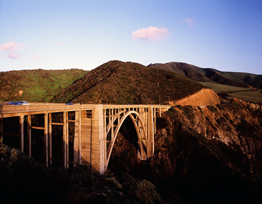Bayview (South San Francisco) Opera House |
Carson Mansion |
 Built in 1888 by South San Francisco Masonic Lodge No. 212 as a performance hall adjoining their lodge, the 300-seat South San Francisco Opera House (now known as the Bayview Opera House) was the first cultural building in the neighborhood and served for decades as the social hub of the Bayview Hunters Point district. The Bayview Opera House is now a community cultural center in San Francisco’s most underserved neighborhood and its restoration, which is still in progress, is transforming what was a dilapidated facility into an elegant venue worthy of the pride of the community. |
 Constructed in 1886 for Humboldt Bay lumber baron William Carson, the Carson Mansion is considered one of the finest examples of Queen Anne style architecture in the United States. The house was designed by San Francisco architects Samuel and Joseph Cather Newsome, and built using local redwood. By far the grandest house in Eureka, this distinctive mansion is one of the most recognizable in the entire state. The Carson Mansion has operated as a private members-only club since the 1950s. |
Roundhouse at Indian Grinding Rock State Historic Park |
Bixby Creek Bridge |
 The reconstructed roundhouse at Indian Grinding Rock State Historic Park, Amador County, is used today for dances and ceremonies throughout the year. At 60 feet in diameter, it is one of the largest roundhouses in existence. When it is not being used by Native American groups, it is open to the public. |
 The Bixby Bridge, or Bixby Creek Bridge, opened in 1932 in Big Sur. It is a reinforced concrete open-spandrel arch bridge located 120 miles south of San Francisco along California Highway One (the Pacific Coast Highway). It is one of the tallest single-span concrete bridges in the world and one of the most photographed bridges along the Pacific Coast. |
Rust General Store at Old Town San Diego State Historic Park |
Fort Humboldt State Historic Park |
 Considered the “birthplace” of California, Old Town San Diego presents the opportunity for visitors to connect the present with the past. Old Town San Diego gives one insight into the lives of those living during the Mexican period through the early American period in California. A rich vein of cultural history, Old Town San Diego is home to many historic buildings including San Diego’s first school house. |
 Located just south of Eureka, Fort Humboldt was established in 1853 to mediate conflicts between Native Americans and white settlers brought by the gold mining boom. Future Union Army General and U.S. President Ulysses S. Grant was stationed at the fort for a short time in its early years. Fort Humboldt was abandoned in 1870. |
Chicano Park Murals |
Golden Gate Bridge |
 Chicano Park is located in San Diego’s Barrio Logan neighborhood, beneath the east-west approach ramps of the San Diego-Coronado Bay Bridge. The property is important for its association with the April 22, 1970, takeover of the area by members of the Barrio Logan community in response to news that a California Highway Patrol substation was under construction on the site, previously identified as a location for a proposed neighborhood park. This community action resulted in the establishment of Chicano Park as a public park, featuring murals that commemorate the park’s creation, the history of the community, and iconography of the Chicano Movement. |
 Construction of the Golden Gate Bridge lasted from 1933 until May of 1937. Among the 10 longest suspension bridges in the world, the bridge crosses the Golden Gate Strait, connecting San Francisco to Marin County to the north. As of May 2012, close to 2 billion vehicles have crossed the bridge since it opened to vehicular traffic in 1937. |
Krug Winery Carriage House |
|
 The 1881 Carriage House at the Charles Krug Winery near St. Helena in the Napa Valley underwent an extensive rehabilitation in 2007. The interior second floor of the Carriage House has now become a spectacular entertainment facility, the floor and ceiling produced from re-milled redwood from the redwood fermentation tanks that had originally been housed in the winery’s 1872 Redwood Cellar. The Krug Winery, the oldest winery in the Napa Valley, is a California Historical Landmark. |
